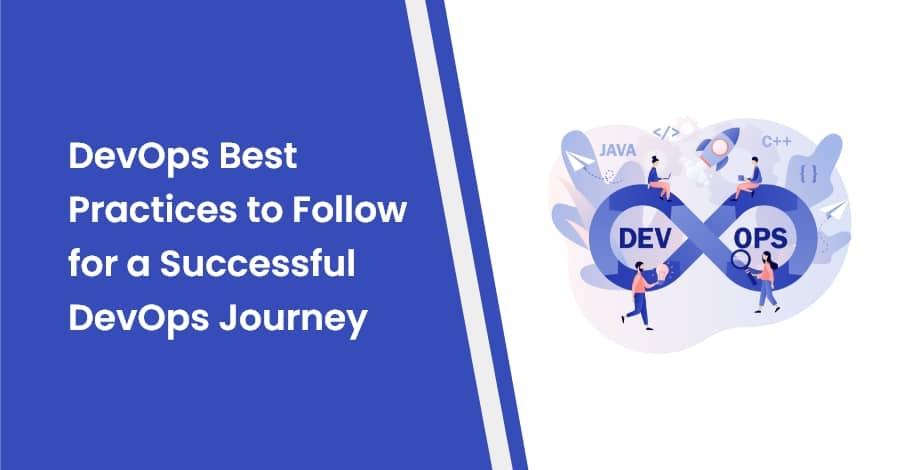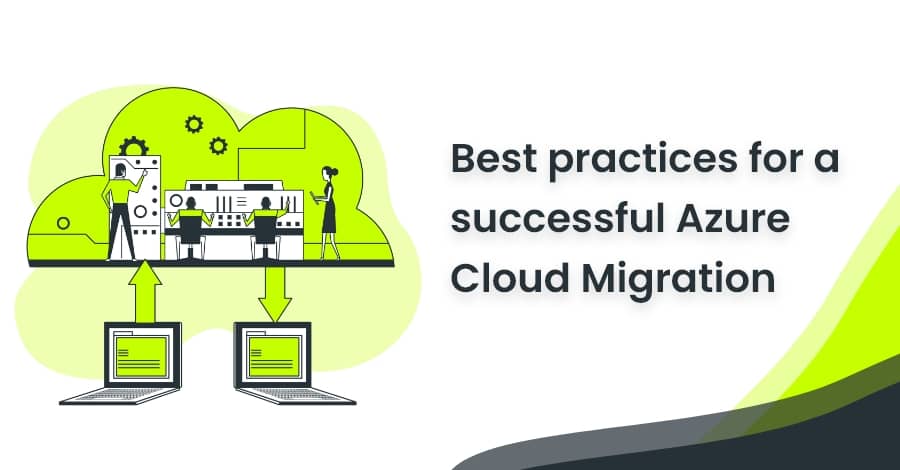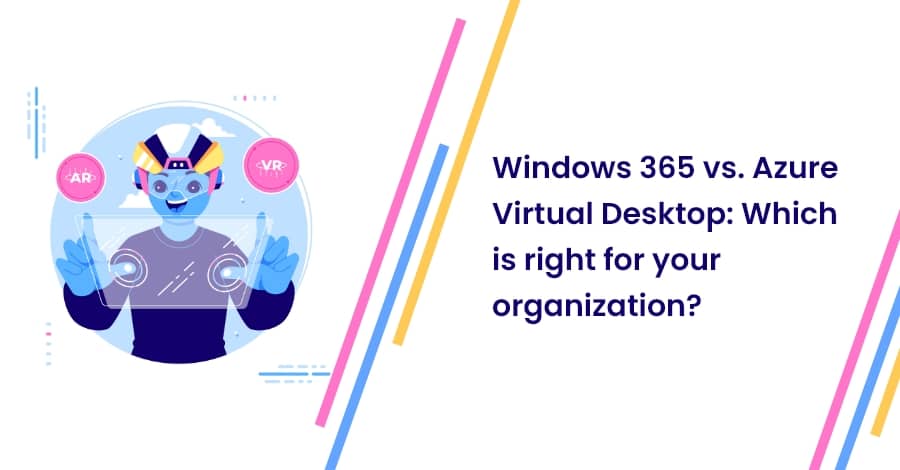
21 Oct DevOps Best Practices to Follow for a Success
21 October 2022

DevOps is a software development methodology that aims to break down the barriers between development and operations teams to improve software quality and speed of delivery. This approach is increasingly popular among software development teams and has become an essential component of many organizations’ software development processes. In this article, we will discuss the top 8 best practices for implementing DevOps, including agile project management, shift left with CI/CD, building with the right tools, implementing automation, monitoring the DevOps pipeline and applications, observability, gathering continuous feedback, and changing the culture.
Top 8 DevOps Best Practices for Successful Implementation
- Agile Project Management
Agile project management is an iterative approach to project management and software development that emphasizes flexibility and customer satisfaction. Agile teams focus on delivering work in smaller increments, instead of waiting for a single massive release date. This allows teams to respond to feedback and pivot as necessary. Key concepts for agile project management include starting with a workflow that includes four phases: to do, in progress, code review, and done. Teams should break large-scale projects into smaller tasks and respond to changes in needs or scope as they make progress. Two core frameworks for teams practicing agile methodology are Scrum and Kanban.
- Shift Left with CI/CD
When teams “shift left,” they bring testing into their code development processes early. Instead of sending multiple changes to a separate test or QA team, a variety of tests are performed throughout the coding process so that developers can fix bugs or improve code quality while they work on the relevant section of the codebase. The DevOps best practice of continuous integration and continuous delivery (CI/CD) underpins the ability to shift left. This approach involves automating the build, test, and deployment processes to ensure that changes are validated and deployed quickly and consistently.
- Build with the Right Tools
A DevOps toolchain requires the right tools for each phase of the DevOps lifecycle, with key capabilities to improve software quality and speed of delivery. Teams should choose DevOps tools that are appropriate for their organization’s needs and goals and review the functionality of each tool for each phase of the DevOps lifecycle. This may include tools for code management, continuous integration, continuous delivery, testing, deployment, and monitoring.
At Star Knowledge, we identify the right set of tools like Jenkins, Docker, Puppet, Kubernetes, Selenium, Vault, Jira, and Azure DevOps across various stages of your DevOps software lifecycle, including development, CI/CD, testing, configuration management, version controls, monitoring, and so on.
- Implement Automation
Continuous integration and delivery allows developers to merge code regularly into the main repository. Instead of manually checking code, CI/CD automates this process, from batching in a specified window to frequent commits. In addition to CI/CD, automated testing is essential to successful DevOps best practices. Automated tests might include end-to-end testing, unit tests, integration tests, and performance tests. Automation improves the speed of development tremendously, but it is important to monitor the DevOps pipeline and applications to ensure that a broken build or failed test does not cause unnecessary delays.
- Monitor the DevOps Pipeline and Applications
It’s important to monitor the DevOps pipeline so that a broken build or failed test doesn’t cause unnecessary delays. Automation improves the speed of development tremendously, but if there is a failure in an automated process and nobody knows about it, you’re better off doing the work manually. In a similar vein, it’s important to monitor production applications in order to identify failures or performance deficiencies before customers do.
- Observability
As the industry moved away from monolithic, on-premise systems and applications to cloud-native, microservice-based applications, monitoring is now considerably more complex. As a result, there is an increasing interest in observability. It is often said that the three pillars of observability are logs, traces, and metrics. Logs are generated by most systems components and applications and consist of time-series data about the functioning of the system or application. Traces track the flow of logic within the application. Metrics include CPU/RAM reservation or usage, disk space, network connectivity, and more.
- Gather Continuous Feedback
Continuous feedback is an essential best practice for any successful DevOps team. It ensures that team members have all the information needed to do their jobs on a timely basis. From the development perspective, this means that the team is alerted to any pipeline failures immediately. It also means that clear, thorough code test results are made available to the developers as quickly as possible. From the product management perspective, the team is made aware of any production failures or performance deficiencies or reported bugs.
Continuous feedback ensures that the team can make necessary changes in a timely manner, which leads to faster and better-quality releases. In the past, there was a widespread belief that a development team could only optimize for speed or quality. Continuous feedback is one of the elements of DevOps that makes it possible to have both.
- Change the Culture
DevOps requires collaboration, transparency, trust, and empathy. If your organization is one of the rare ones where these qualities are already established, it should be fairly easy for your teams to adopt DevOps best practices. If not, some effort will be required to develop these qualities. The most common organizational structures are siloed, meaning different teams have separate areas of ownership and responsibility, and there is minimal cross-team communication or collaboration. For DevOps to succeed, these barriers must be eliminated by adopting the “you build it, you run it” practice. This doesn’t mean there aren’t people or teams who specialize, only that the lines of communication and collaboration between teams are open and used.
It’s essential to create a culture of trust and open communication between the teams, where everyone is responsible for the entire delivery process. This ensures that everyone understands the impact of their work on the entire process, which leads to better collaboration, more efficient processes, and ultimately, higher-quality software.
Honing your DevOps practices is an ongoing journey. Focus on the people and processes as you start your DevOps transformation, and incorporate advanced tooling, integration, and feature functionality as you become a mature team.
Conclusion
DevOps is a set of practices that can help organizations deliver software faster and with higher quality. By focusing on continuous delivery, automation, monitoring, and feedback, organizations can create a culture of collaboration, transparency, and trust, which leads to better communication and better software. Implementing DevOps requires careful planning and execution, but the benefits are worth the effort. As organizations continue to move towards cloud-native, microservice-based applications, the need for DevOps best practices will only continue to grow.
Star Knowledge is the best cloud and DevOps consulting company that assists businesses in beginning their journey of DevOps. We’re focused on helping software development and IT Consulting companies with DevOps implementation, engineering as well as cloud-based solutions. Contact us for a perfect DevOps-enabled organization.
Our Related Posts
Public Cloud vs. Private Cloud – Which is Right for Your Business?
Digital transformation is happening at breakneck speed. Companies are looking to leverage the power of digital.….
Best practices for a successful Azure Cloud Migration
As the demands of the modern market continue to grow, more and more businesses are realizing that their….
Windows 365 vs. Azure Virtual Desktop: Which is right for your organization?
Today, a lot of businesses are addressing challenges with a hybrid workforce and preparing ….









No Comments